Do Movement Patterns of GPS-Tracked Cattle on Extensive Rangelands Suggest Independence among Individuals?
Abstract
:1. Introduction
2. Material and Methods
2.1. Study Sites
2.2. GPS Cattle Tracking
2.3. Analysis of Association Patterns
3. Results
4. Discussion
4.1. When Are Cattle Movements Independent?
4.2. Association of GPS-Tracked Cattle
4.3. Number of GPS-Tracked Animals
5. Conclusions
Acknowledgments
Author Contributions
Conflicts of Interest
References
- Ganskopp, D. Manipulating cattle distribution with salt and water in large arid-land pastures: A GPS/GIS assessment. Appl. Anim. Behav. Sci. 2001, 73, 251–262. [Google Scholar] [CrossRef]
- Ganskopp, D.; Bohnert, D. Do pasture-scale nutritional patterns affect cattle distribution on rangelands? Rangel. Ecol. Manag. 2006, 59, 189–196. [Google Scholar] [CrossRef]
- Bailey, D.W.; VanWagoner, H.C.; Weinmeister, R.; Jensen, D. Evaluation of low-stress herding and supplement placement for managing cattle grazing in riparian and upland areas. Rangel. Ecol. Manag. 2008, 61, 26–37. [Google Scholar] [CrossRef]
- Bailey, D.W.; Thomas, M.G.; Walker, J.W.; Witmore, B.K.; Tolleson, D. Effect of previous experience on grazing patterns and diet selection of Brangus Cows in the Chihuahuan desert. Rangel. Ecol. Manag. 2010, 63, 223–232. [Google Scholar] [CrossRef]
- Swain, D.L.; Friend, M.A.; Bishop-Hurley, G.J.; Handcock, R.N.; Wark, T. Tracking livestock using global positioning systems—Are we still lost? Anim. Prod. Sci. 2011, 51, 167–175. [Google Scholar] [CrossRef]
- Weber, K.T.; Burcham, M.; Marcum, C.L. Assessing independence of animal locations with association matrices. J. Range Manag. 2001, 54, 21–24. [Google Scholar] [CrossRef]
- Valcu, M.; Kempenaers, B. Spatial autocorrelation: An overlooked concept in behavioral ecology. Behav. Ecol. 2010, 21, 902–905. [Google Scholar] [CrossRef] [PubMed]
- Boyce, M.S.; Pitt, J.; Northrup, J.M.; Morehouse, A.T.; Knopff, K.H.; Cristescu, B.; Stenhouse, G.B. Temporal autocorrelation functions for movement rates from global positioning system radio telemetry data. Philos. Trans. R. Soc. B 2010, 365, 2213–2219. [Google Scholar] [CrossRef] [PubMed]
- Perotto-Baldivieso, H.L.; Cooper, S.M.; Cibils, A.F.; Figueroa-Pagan, M.; Udaeta, K.; Black-Rubio, C.M. Detecting autocorrelation problems from GPS collar data in livestock studies. Appl. Anim. Behav. Sci. 2012, 136, 117–125. [Google Scholar] [CrossRef]
- Roath, L.R.; Krueger, W.C. Cattle grazing and behavior on a forested range. J. Range Manag. 1982, 35, 332–338. [Google Scholar] [CrossRef]
- Lazo, A. Social segregation and the maintenance of social stability in a feral cattle population. Anim. Behav. 1994, 48, 1133–1141. [Google Scholar] [CrossRef]
- Harris, N.R.; Johnson, D.E.; McDouglad, N.K.; George, M.R. Social associations and dominance of individuals in small herds of cattle. Rangel. Ecol. Manag. 2007, 60, 339–349. [Google Scholar] [CrossRef]
- Stephenson, M.B.; Bailey, D.W.; Jensen, D. Associations patterns of visually-observed cattle on Montana, USA foothill rangelands. Appl. Anim. Behav. Sci. 2016, 178, 7–15. [Google Scholar] [CrossRef]
- Hacker, R.B.; Norton, B.E.; Owens, M.K.; Frye, D.O. Grazing crested wheatgreass, with particular reference to effects of pasture size. J. Range Manag. 1988, 41, 73–78. [Google Scholar] [CrossRef]
- Rook, A.J.; Penning, P.D. Synchronisation of eating, ruminating and idling activity by grazing sheep. Appl. Anim. Behav. Sci. 1991, 32, 157–166. [Google Scholar] [CrossRef]
- Hurlbert, S.H. Pseudoreplication and the design of ecological field experiments. Ecol. Monogr. 1984, 54, 187–211. [Google Scholar] [CrossRef]
- Anderson, D.M. Geospatial methods and data analysis for assessing distribution of grazing livestock. In Proceedings of the 4th Grazing Livestock Nutrition Conference, Estes Park, CO, USA, 9–10 July 2010; pp. 57–90. [Google Scholar]
- Clark, P.E.; Lee, J.; Ho, K.; Nielson, R.M.; Johnson, D.E.; Ganskopp, D.C.; Chigbrow, J.; Pierson, F.B.; Hardegree, S.P. Prescribed fire effects on resource selection by cattle in mesic sagebrush steppe. Part 1: Spring grazing. J. Arid Environ. 2014, 100, 78–88. [Google Scholar] [CrossRef]
- Bailey, D.W.; Lunt, S.; Lipka, A.; Thomas, M.G.; Medrano, J.F.; Cánovas, A.; Rincon, G.; Stephenson, M.B.; Jensen, D. Genetic influences on cattle grazing distribution: Association of genetic markers with terrain use in cattle. Rangel. Ecol. Manag. 2015, 68, 142–149. [Google Scholar] [CrossRef]
- Bailey, D.W.; Marta, S.; Jensen, D.; Boss, D.L.; Thomas, M.G. Genetic and environmental influences on distribution patterns of beef cattle grazing foothill rangeland. Proc. West. Sect. Am. Soc. Anim. Sci. 2010, 61, 64–66. [Google Scholar]
- Frair, J.L.; Merrill, E.H.; Allen, J.R.; Boyce, M.S. Know thy enemy: Experience affects elk translocation success in risky landscapes. J. Wildl. Manag. 2007, 71, 541–554. [Google Scholar] [CrossRef]
- Long, R.A.; Rachlow, J.L.; Kie, J.G. Effects of season and scale on response of elk and mule deer to habitat manipulation. J. Wildlife Manag. 2008, 72, 1133–1142. [Google Scholar] [CrossRef]
- Long, R.A.; Muir, J.D.; Rachlow, J.L.; Kie, J.G. A comparison of two modeling approaches for evaluating wildlife-habitat relationships. J. Wildlife Manag. 2009, 73, 294–302. [Google Scholar] [CrossRef]
- Lendrum, P.E.; Anderson, C.R., Jr.; Long, R.A.; Kie, J.G.; Bowyer, R.T. Habitat selection by mule deer during migration: Effects of landscape structure and natural-gas development. Ecosphere 2012, 3, 1–19. [Google Scholar] [CrossRef]
- Bailey, D.W.; Gross, J.E.; Laca, E.A.; Rittenhouse, L.R.; Coughenour, M.B.; Swift, D.M.; Sims, P.L. Mechanisms that result in large herbivore grazing distribution patterns. J. Range Manag. 1996, 49, 386–400. [Google Scholar] [CrossRef]
- Whitehead, H. Analyzing Animal Societies: Quantitative Methods for Vertebrate Social Analysis; University of Chicago Press: Chicago, IL, USA, 2008; p. 336. [Google Scholar]
- Finger, A.; Patison, K.P.; Heath, B.M.; Swain, D.L. Changes in the group associations of free-ranging beef cows at calving. Anim. Prod. Sci. 2014, 54, 270–276. [Google Scholar] [CrossRef]
- Shaw, R.A. Social organization and decision making in North American Bison: Implications for management. Ph.D. Thesis, Utah State University, Logan, UT, USA, 2012; p. 123. [Google Scholar]
- Cairns, S.J.; Schwager, S.J. A comparison of association indexes. Anim. Behav. 1987, 35, 1454–1469. [Google Scholar] [CrossRef]
- Stricklin, W.R. Matrilinear social dominance and spatial relationships among Angus and Hereford cows. J. Anim. Sci. 1983, 57, 1397–1405. [Google Scholar] [CrossRef] [PubMed]
- Boe, K.E.; Faerevik, G. Grouping and social preferences in calves, heifers, and cows. Appl. Anim. Behav. Sci. 2003, 80, 175–190. [Google Scholar] [CrossRef]
- Minta, S.C. Tests of spatial and temporal interactions among animals. Ecol. Appl. 1992, 2, 178–188. [Google Scholar] [CrossRef] [PubMed]
- Sowell, B.F.; Mosley, J.C.; Bowman, J.P.G. Social behavior of grazing beef cattle: Implications for management. Proc. Am. Soc. Anim. Sci. 1999, 78, E18. [Google Scholar] [CrossRef]
- Šárová, R.; Špinka, M.; Stěhulová, I.; Cearcero, F.; Šimečková, M.; Kotrba, R. Pay respect to the elders: Age, more than body mass, determines dominance in female beef cattle. Anim. Behav. 2013, 86, 1315–1323. [Google Scholar] [CrossRef]
- Bowman, J.G.; Sowell, B.F. Delivery method and supplement consumption by grazing ruminants: A review. J. Anim. Sci. 1997, 75, 543–550. [Google Scholar] [CrossRef] [PubMed]
- Howery, L.D.; Provenza, F.D.; Banner, R.E.; Scott, C.B. Differences in home range and habitat use among individuals in a cattle herd. Appl. Anim. Behav. Sci. 1996, 49, 305–320. [Google Scholar] [CrossRef]
- Howery, L.D.; Provenza, F.D.; Banner, R.E.; Scott, C.B. Social and environmental factors influence cattle distribution on rangeland. Appl. Anim. Behav. Sci. 1998, 55, 231–244. [Google Scholar] [CrossRef]
- Lunt, S.T. Modifying individual grazing distribution patterns of cows in extensive rangeland pastures through genetic selection. Master’s Thesis, New Mexico State University, Las Cruces, NM, USA, 2013; p. 122. [Google Scholar]
- Dwyer, D.D. Activities and Grazing Preferences of Cow with Calves in Northern Osage County, Oklahoma; Oklahoma Agricultural Experiment Station: Stillwater, OK, USA, 1961; p. 61. [Google Scholar]
- Murphey, R.M.; de Moura Duarte, F.A. Social aggregations in cattle. II. Contributions of familiarity and genetic similarity. Behav. Genet. 1990, 20, 355–368. [Google Scholar] [CrossRef] [PubMed]
- Takeda, K.; Sato, S.; Sugawara, K. The number of farm mates influences social and maintenance behaviours of Japanese black cows in a communal pasture. Appl. Anim. Behav. Sci. 2000, 67, 181–192. [Google Scholar] [CrossRef]
- Patison, K.P.; Swain, D.L.; Bishop-Hurley, G.J.; Robins, G.; Pattison, P.; Reid, D.J. Changes in temporal and spatial associations between pairs of cattle during the process of familiarization. Appl. Anim. Behav. Sci. 2010, 128, 10–17. [Google Scholar] [CrossRef]
- Sato, S.H.; Sassa, H.; Sonoda, T. The change in social behaviour of newly introduced heifers with original group cows. Anim. Sci. Technol. 1991, 62, 83–92. [Google Scholar] [CrossRef]
- Laca, E.A. New approaches and tools for grazing management. Rangel. Ecol. Manag. 2009, 62, 407–417. [Google Scholar] [CrossRef]
- Bailey, D.W.; Keil, M.R.; Rittenhouse, L.R. Daily movement patterns of hill climbing and bottom dwelling cows. J. Range Manag. 2004, 57, 20–28. [Google Scholar] [CrossRef]
- Hunt, L.P.; Petty, S.; Cowley, R.; Fisher, A.; Ash, A.J.; MacDonald, N. Factors affecting the management of cattle grazing distribution in northern Australia: Preliminary observations on the effect of paddock size and water points. Rangel. J. 2007, 29, 169–179. [Google Scholar] [CrossRef]
- Kimura, D.; Ihobe, H. Feral cattle (Bos taurus) on Kuchinoshima Island, southwestern Japan: Their stable ranging and unstable grouping. J. Ethol. 1985, 3, 39–47. [Google Scholar] [CrossRef]
- Mench, J.A.; Swanson, J.C.; Stricklin, W.R. Social stress and dominance among group members after mixing beef cows. Can. J. Anim. Sci. 1990, 70, 345–354. [Google Scholar] [CrossRef]
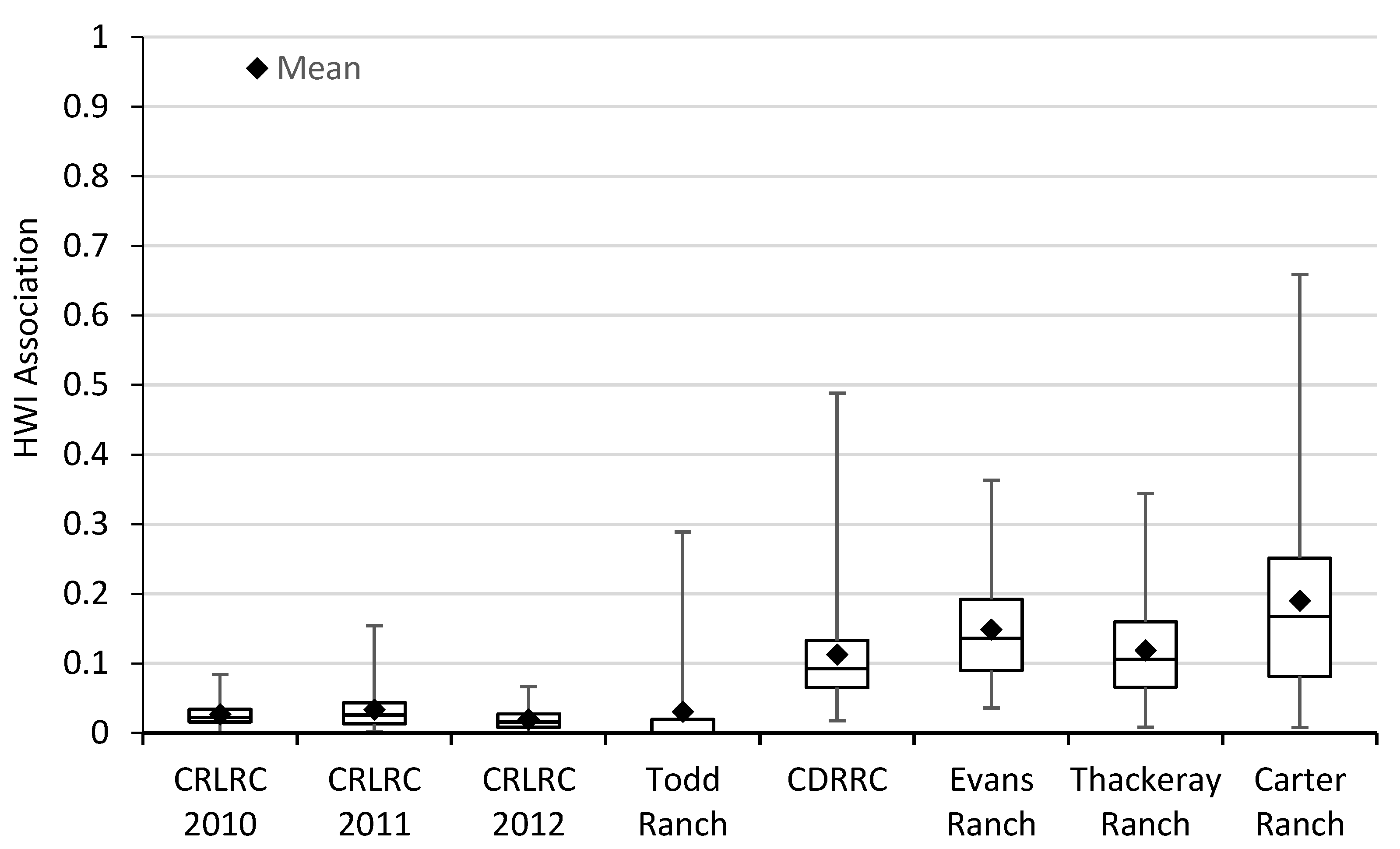
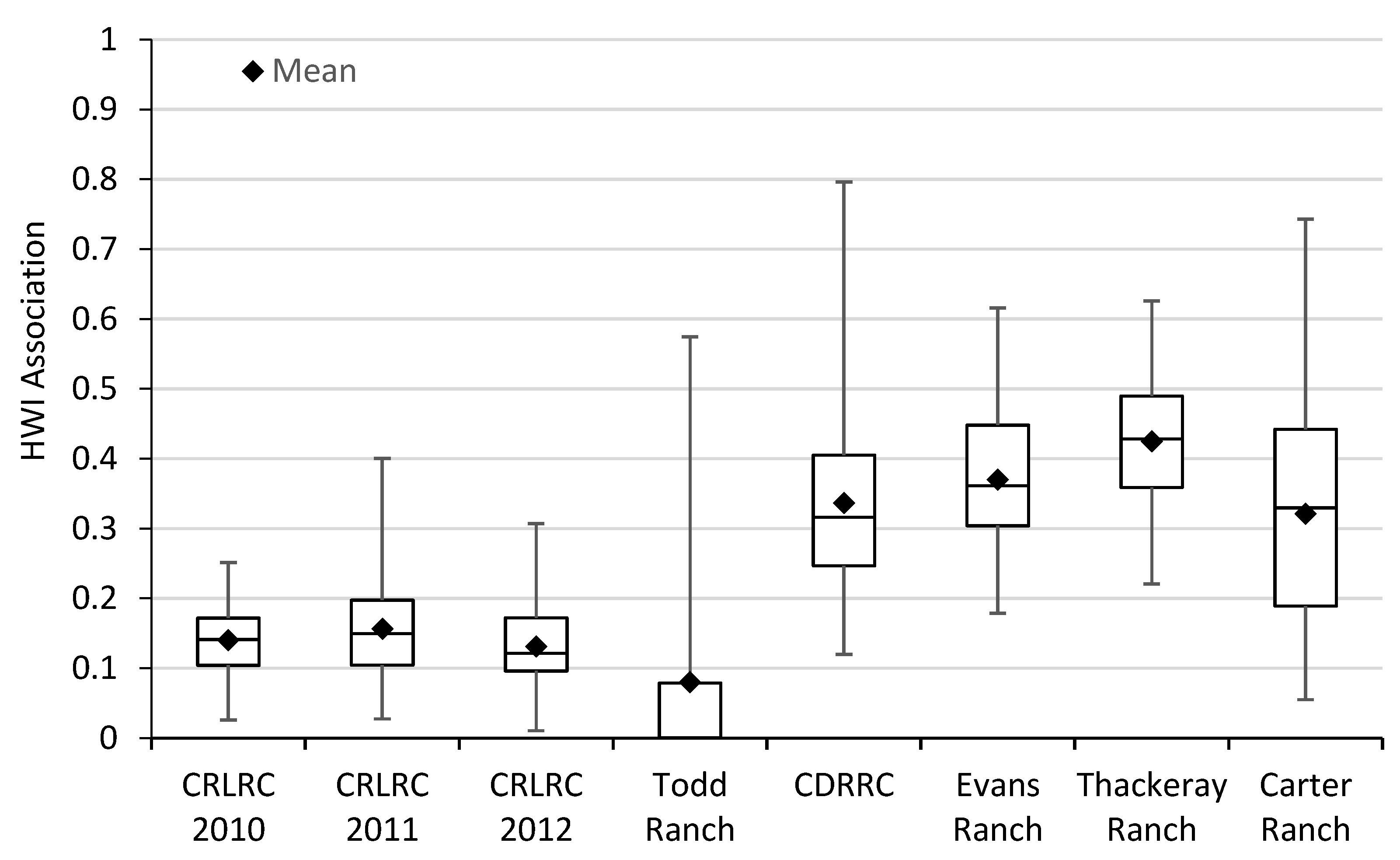
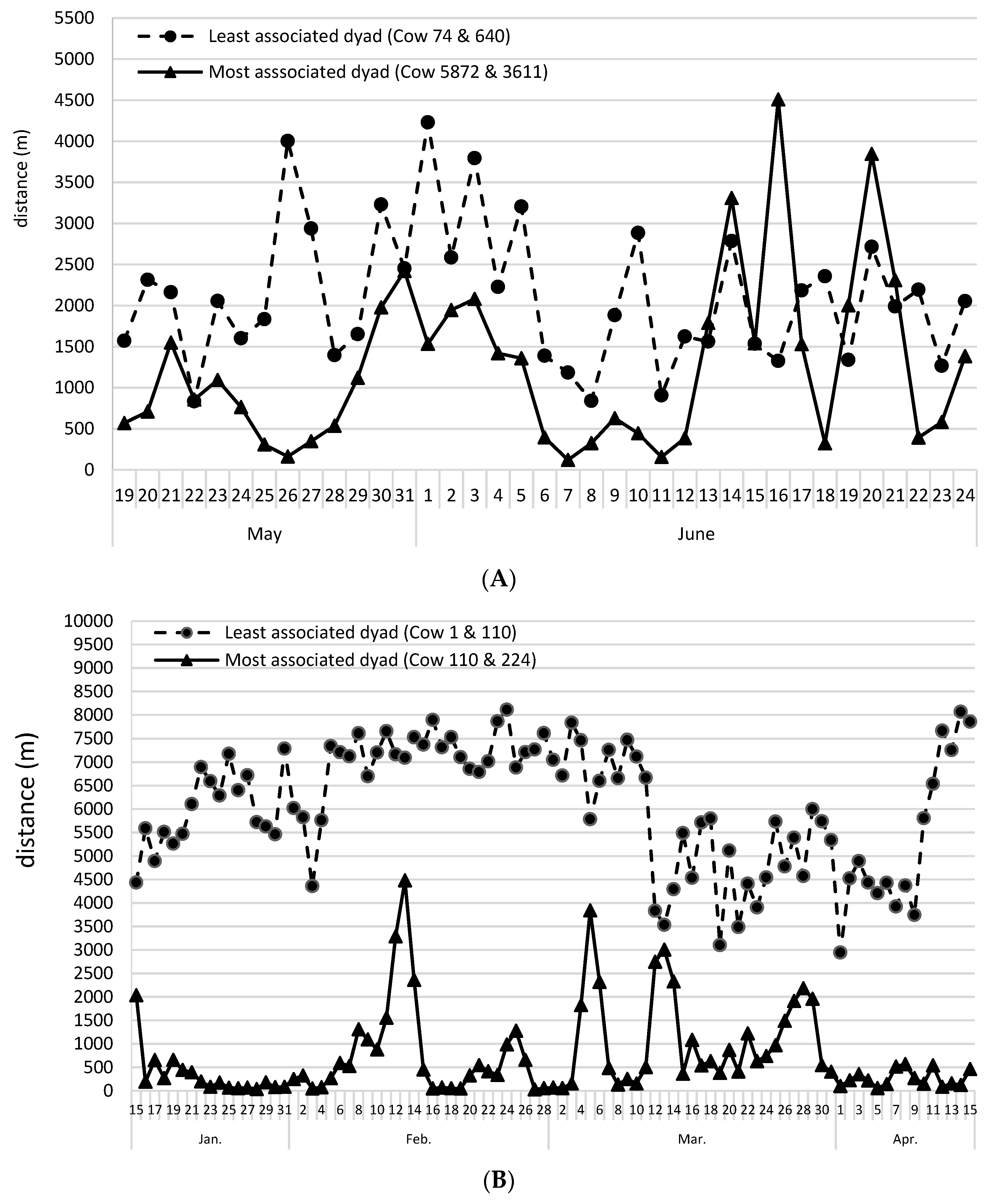
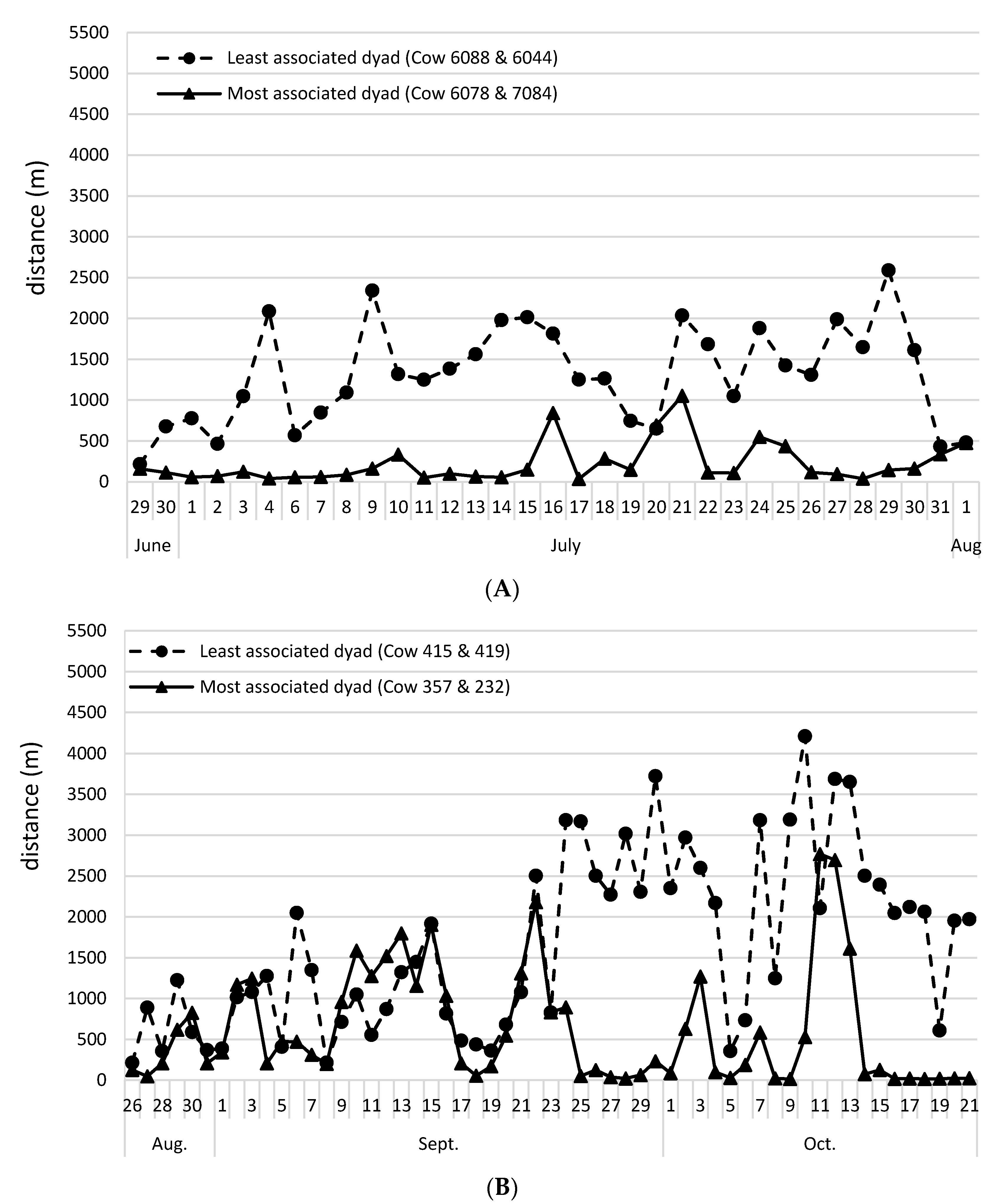
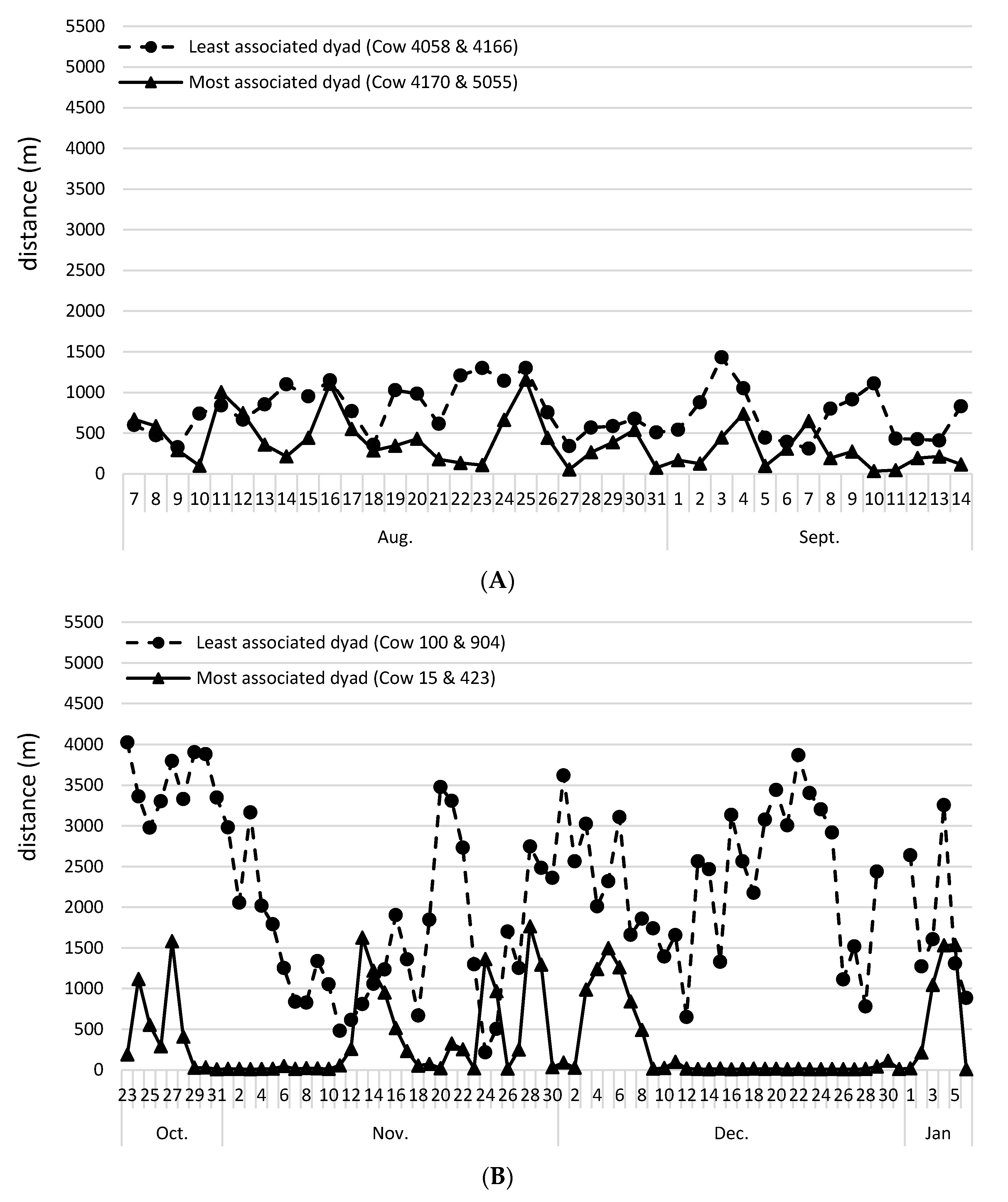

| Ranch | Latitude | Longitude | Terrain | Elevation (m) | Slope (%) | Maximum Distance to Water (km) | Annual Precipitation (mm) * |
|---|---|---|---|---|---|---|---|
| NMSU CRLRC | 34°15′ N | 105°27′ W | Rolling | 1765–1851 | 0–32 | 4.7 | 317 in 2010 159 in 2011 134 in 2012 (370) |
| NMSU CDRRC | 32°31′ N | 106°48′ W | Rolling with arroyos | 1250–1402 | 1–15 | 10.0 | 168 (234) |
| MSU Thackeray Ranch | 48°21′ N | 109°36′ W | Rugged | 1170–1400 | 0–107 | 1.5 | 328 (290) |
| Carter Ranch | 32°29′ N | 109°16′ W | Rolling | 1081–1250 | 0–29 | 3.1 | 137 (249) |
| Todd Ranch | 32°15′ N | 109°56′ W | Rugged and gentle | 1276–2010 | 1–130 | 4.8 | 237 (309) |
| Evans Ranch | 32°30′ N | 108°31′ W | Rugged and moderate | 1670–1902 | 1–77 | 4.8 | 188 (402) |
| Ranch | Start Date | End Date | Length of Tracking (day) | Pasture Size (ha) | Water Sources | Herd Size | Number of GPS-Tracked Cows (n) | Number of Dyadic Associations 1 |
|---|---|---|---|---|---|---|---|---|
| NMSU CRLRC | 5/17/2010 | 7/19/2010 | 63 | 1601 | 1 | 120 | 14 | 91 |
| 5/19/2011 | 6/22/2011 | 34 | 1601 | 1 | 110 | 12 | 66 | |
| 6/28/2012 | 8/17/2012 | 50 | 1601 | 1 | 140 | 17 | 136 | |
| NMSU CDRRC | 6/29/2011 | 8/1/2011 | 33 | 3990 | 1 | 43 | 16 | 120 |
| MSU Thackeray Ranch | 8/8/2011 | 9/14/2011 | 37 | 336 | 3 | 213 | 17 | 136 |
| Carter Ranch | 10/21/2011 | 1/6/2012 | 77 | 4776 | 6 | 125 | 11 | 55 |
| Todd Ranch | 1/15/2011 | 4/15/2011 | 90 | 9740 | 20 | 250 | 15 | 105 |
| Evans Ranch | 8/26/2012 | 10/21/2012 | 56 | 1994 | 2 | 37 | 15 | 105 |
| Study Site | Number of Associations at HWI > 0.25 at 75 m | ||||||||
|---|---|---|---|---|---|---|---|---|---|
| 0 | 1 | 2 | 3 | 4 | 5 | 6 | 7 | Total | |
| ---------------------------------- cows -------------------------------- | |||||||||
| CRLRC 2010 | 14 | 0 | 0 | 0 | 0 | 0 | 0 | 0 | 14 |
| CRLRC 2011 | 12 | 0 | 0 | 0 | 0 | 0 | 0 | 0 | 12 |
| CRLRC 2012 | 17 | 0 | 0 | 0 | 0 | 0 | 0 | 0 | 17 |
| Todd Ranch | 13 | 2 | 0 | 0 | 0 | 0 | 0 | 0 | 15 |
| CDRRC | 5 | 6 | 3 | 2 | 0 | 0 | 0 | 0 | 16 |
| Evans Ranch | 5 | 5 | 3 | 0 | 1 | 1 | 0 | 0 | 15 |
| Thackeray Ranch | 10 | 3 | 3 | 1 | 0 | 0 | 0 | 0 | 17 |
| Carter Ranch | 1 | 3 | 2 | 1 | 3 | 0 | 1 | 0 | 11 |
| Study Site | Number of Associated Cows at HWI > 0.5 at 500 m | ||||||||
|---|---|---|---|---|---|---|---|---|---|
| 0 | 1 | 2 | 3 | 4 | 5 | 6 | 7 | Total | |
| ---------------------------------- cows -------------------------------- | |||||||||
| CRLRC 2010 | 14 | 0 | 0 | 0 | 0 | 0 | 0 | 0 | 14 |
| CRLRC 2011 | 12 | 0 | 0 | 0 | 0 | 0 | 0 | 0 | 12 |
| CRLRC 2012 | 17 | 0 | 0 | 0 | 0 | 0 | 0 | 0 | 17 |
| Todd Ranch | 12 | 1 | 2 | 0 | 0 | 0 | 0 | 0 | 15 |
| CDRRC | 4 | 4 | 3 | 4 | 1 | 0 | 0 | 0 | 16 |
| Evans Ranch | 3 | 4 | 3 | 2 | 1 | 2 | 0 | 0 | 15 |
| Thackeray Ranch | 2 | 0 | 2 | 5 | 5 | 1 | 0 | 2 | 17 |
| Carter Ranch | 6 | 2 | 3 | 0 | 0 | 0 | 0 | 0 | 11 |
© 2017 by the authors. Licensee MDPI, Basel, Switzerland. This article is an open access article distributed under the terms and conditions of the Creative Commons Attribution (CC BY) license (http://creativecommons.org/licenses/by/4.0/).
Share and Cite
Stephenson, M.B.; Bailey, D.W. Do Movement Patterns of GPS-Tracked Cattle on Extensive Rangelands Suggest Independence among Individuals? Agriculture 2017, 7, 58. https://doi.org/10.3390/agriculture7070058
Stephenson MB, Bailey DW. Do Movement Patterns of GPS-Tracked Cattle on Extensive Rangelands Suggest Independence among Individuals? Agriculture. 2017; 7(7):58. https://doi.org/10.3390/agriculture7070058
Chicago/Turabian StyleStephenson, Mitchell B., and Derek W. Bailey. 2017. "Do Movement Patterns of GPS-Tracked Cattle on Extensive Rangelands Suggest Independence among Individuals?" Agriculture 7, no. 7: 58. https://doi.org/10.3390/agriculture7070058
APA StyleStephenson, M. B., & Bailey, D. W. (2017). Do Movement Patterns of GPS-Tracked Cattle on Extensive Rangelands Suggest Independence among Individuals? Agriculture, 7(7), 58. https://doi.org/10.3390/agriculture7070058





